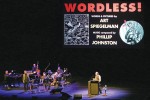Comics, once considered niche market fare, have now become the quintessence of cool. In fact, people who read comic books even land dates nowadays, according to graphic novelist Art Spiegelman.
In “WORDLESS!,” a hybrid performance of slides, talk and jazz performance, Spiegelman and composer Phillip Johnston guide the audience through a tour of the significant graphic novels of the past and present. Originally commissioned by the Sydney Opera House for a program called GRAPHIC, “WORDLESS!” came to Royce Hall on Wednesday as the first show in the Center for the Art of Performance’s 2014-2015 season.
Spiegelman received the Pulitzer prize in 1992 for his graphic novel “Maus,” which depicts Spiegelman interviewing his father about his life as a Polish Jew and Holocaust survivor. While Wednesday’s performance incorporated slides from Spiegelman’s own work, the focus of the performance was on the work of other artists.
“I’ve been called the father of the graphic novel,” Spiegelman said. “But I’m here tonight to demand a paternity test.”
This became the guiding structure for the rest of the performance. One by one, Spiegelman discussed the work of seven graphic novelists who had a profound influence on the history of the graphic novel and on his own work.
For some artists, Spiegelman presented slides of complete graphic novels, including Lynd Ward’s “Gods’ Man.” The slides were arranged in a pre-choreographed rhythm and were accompanied by energetic bursts or intricate intervals of music performed by the jazz band.
By guiding the audience through the graphic novel slides at his own pace, Spiegelman compelled readers to give the images more consideration than they likely would have in self-guided skimming.
Like the performance, which featured a collaboration between music and slides, comics also exist in a hyphen space between words and pictures, of the comic and serious, Spiegelman said.
Spiegelman alternated between presenting humorous, lighthearted works and heavier, reflective ones. Despite the tonal differences between works, each contained themes that are worthy of thought, including capitalism and oppression, all packaged in dramatic, hyperbolic or romantic storylines and artwork.
Spiegelman himself preferred quips to lengthy explanations and often straddled the comic-serious hyphen. Even at an emotional climax in the performance, Spiegelman explained, in an impersonal, matter-of-fact tone, how his attempt to understand his mother’s suicide inspired one of his works, “Prisoner on the Hell Planet.”
The graphic novels’ joining of the comedic and serious was reinforced by the jazz accompaniments. While the combination of music and images was undoubtedly an experiment in synthesizing art forms, the tones interweaved seamlessly, achieving the effect of stretching out the length of time encompassed in each frame of graphics.
At different points in the performance, the soprano saxophone mimicked a female voice with surprising similitude and the trombone squealed in unison to a cat on the screen. The music was aptly composed to fit the atmosphere of the slides being represented, heightening the audience’s sense of involvement. The images were infused with a theatrical quality, allowing the audience to consider them either as a thought-inspiring source, a comedic, lighthearted distraction or both.
However, the audience’s focus was spread thin by the stage setup – the jazz band was stage right and lit up with warm yellow light in close proximity to the screen. If an audience member took a short glance at the band to greater appreciate its performance, he or she risked missing what may have been a crucial image among the slides.
This tradeoff was aggravated by the regulated slide speed, which diminished audience members’ freedom to read the often intricate images at their own pace, resulting in reduced overall comprehension. While the gist of the set of images would have been clear, the audience may have found it difficult to understand each story in its entirety.
Overall, though, the dilution of the audience’s comprehension only partially reduced the quality of the viewing experience.
“WORDLESS!” was a successful experiment in the combination of two different modes of expression, music and the graphic novel. It let members of the audience know that in their own lives, such hyphenated pairings, when reconciled, can produce creativity and meaning.
– Eileen Li
